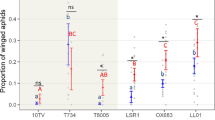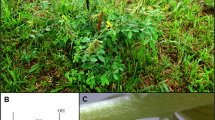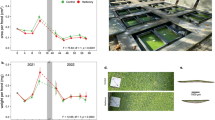Abstract
WHEN studying interactions between trophic levels, ecologiste often restrict their attention to two levels as a means of simplifying the analysis; unfortunately, this simplification can be misleading if tritrophic interactions (such as plant–herbivore–predator) cannot be understood by simply adding together pairwise interactions (plant–herbivore plus herbivore–predator, for example)1,2. We examined the significance of tritrophic interactions by asking how the morphology of the common pea (Pisum sativum) influences the population growth of pea aphids (Acyrthosiphon pisum) in the presence and in the absence of a third trophic level. We found significant interactions between the first trophic level (peas) and the third trophic level (ladybird beetles) in determining aphid population growth. Our results point out how simple genetic changes can yield morphological variants in plants that differ dramatically in their resistance to herbivores due to the effects of plant architecture on enemies of the herbivore.
This is a preview of subscription content, access via your institution
Access options
Subscribe to this journal
Receive 51 print issues and online access
$199.00 per year
only $3.90 per issue
Buy this article
- Purchase on Springer Link
- Instant access to full article PDF
Prices may be subject to local taxes which are calculated during checkout
Similar content being viewed by others
References
Lawton, J. & McNeill, S. Symp. Brit. Ecol. Soc. 20, 223–244 (1979).
Price, P. et al. A. Rev. Ecol. Syst. 76, 456–462 (1983).
Hulspas-Jordan, P. & Van Lenteren, J. Med. Fac. Landbouw. Rijksuniv. Gent 43, 431–440 (1978).
Kauffman, W. C. & Kennedy, G. G. Envir. Ent. 18, 698–704 (1989).
Obrycki, J. J., Tauber, M. J. & Tingey, W. M. J. econ. Ent. 76, 456–462 (1983).
Southwood, T. R. E. in Insects and the Plant Surface (eds Juniper, B. & Southwood, T. R. E.) 1–22 (Edward Arnold, London, 1986).
Carter, M. C. Sutherland, D. & Dixon, A. F. G. Oecologia 63, 394–397 (1984).
Evans, E. W. N.Y. ent. Soc. XC, 129–133 (1982).
Andow, D. L. & Prokrym, D. R. Oecologia 82, 162–165 (1990).
Wehner, T. C. & Gritton, E. T. J. Am. Soc. hort. Sci. 106, 272–278 (1981).
Belcher, D. W. & Thurston, R. Envir. Ent. 11, 91–94 (1982).
Kareiva, P. in Critical Issues in Biological Control (eds Mackauer, E., Ehler, L. & Roland, J.) 213–238 (Intercept, Andover (UK), 1990).
Quilici, S. & Iperti, G. in Ecology of Aphidophaga (ed. Hodek, I.) 99–106 (Academia, Prague/Dr W. Junk, Dordrecht, 1986).
Rotheray, G. E. in Ecology of Aphidophaga (ed. Hodek, I.) 107–111 (Academia, Prague/Dr W. Junk, Dordrecht, 1986).
Shahjahan, M. & Streams, F. A. Envir. Ent. 2, 921–925 (1973).
Bernays, E. & Graham, M. Ecology 69, 886–892 (1988).
Wilkinson, L. Systat, the System for Statistics (SYSTAT Inc., Evanston, 1989).
Author information
Authors and Affiliations
Rights and permissions
About this article
Cite this article
Kareiva, P., Sahakian, R. Tritrophic effects of a simple architectural mutation in pea plants. Nature 345, 433–434 (1990). https://doi.org/10.1038/345433a0
Received:
Accepted:
Issue Date:
DOI: https://doi.org/10.1038/345433a0
This article is cited by
-
Habitat types in the Atlantic Forest differently influence community structure and species interaction of cavity-nesting Hymenoptera and their natural enemies
Journal of Insect Conservation (2023)
-
Effects of habitat complexity on giant water bug (Belostoma) functional response to rams-horn snail prey (Helisoma)
Hydrobiologia (2021)
-
Ecological costs of goldenrod’s ducking strategy in the currency of antixenosis, antibiosis, and indirect resistance to aphids
Evolutionary Ecology (2020)
-
Risk of bird predation and defoliating insect abundance are greater in urban forest fragments than street trees
Urban Ecosystems (2020)
-
A random survival forest illustrates the importance of natural enemies compared to host plant quality on leaf beetle survival rates
BMC Ecology (2018)
Comments
By submitting a comment you agree to abide by our Terms and Community Guidelines. If you find something abusive or that does not comply with our terms or guidelines please flag it as inappropriate.



